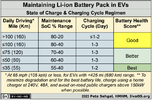Yes. The battery management system will automatically maintain the battery. There are things you can do to help ensure that the Tesla Model Y BMS is able to obtain needed data from the pack. Periodically the BMS needs to be able to measure the open cell voltage (OCV) of each of the cells in the pack. This takes several hours and the Tesla Model Y battery pack must be disconnected from the Tesla vehicle as when in sleep mode. When Sentry mode is left turned on the Tesla Model Y remains in Standby mode (high voltage battery connected) and does not enter Sleep mode.Isn't the Tesla BMS capable of monitoring cells and keep a battery balanced?
It is a good practice to periodically charge to above 94% or 95% so that the Tesla Model Y BMS can collect data at the higher state of charge. Periodically let the battery state of charge fall to 30% or less so that measurements can be collected at this lower state of charge. If the battery is always maintained within a narrow range state of charge the BMS has less data to accurately determine the state of the battery when estimating current state of charge and remaining range outside of the daily charge level.
There is a downside risk of not enabling the Tesla Model Y to periodically enter sleep mode for extended periods so that the OCV measurement can be performed. You could someday be driving the Tesla Model Y, the battery state of charge reading 10% but the vehicle shuts down. This scenario could happen because the BMS was not able to collect needed OCV data to accurately determine the state of the battery across a wide range of state of charge.
When you charge to 100% the Tesla Model Y will display 100% SOC but continue to charge for perhaps an additional 40 minutes. During this time the BMS is assumed to be performing cell balancing and other automated processes. It can take almost an hour longer than you anticipate to charge to 100%. This is one reason not to fully charge to 100% when it is possible to charge to ~95%; charging completes much sooner. I don't have the Tesla documentation but believe that cell balancing will also periodically take place at the completion of charging to less than 100% SOC.
Last edited:



